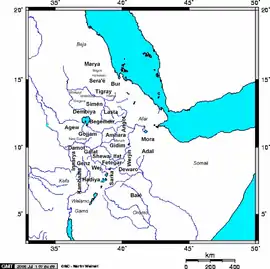Amda Seyon I's Expansions
Amda Seyon I's Expansions (1314–1344) were territorial expansions during the reign of Ethiopian Emperor Amda Seyon I. Motivated by religious, commercial, and territorial factors, Amda Seyon's first conquest was Gojjam and Hadiya in 1316, forcibly seizing Enderta Province, where there was resistance.

Course

While Emperor Yekuno Amlak is considered the founder of the state, the Ethiopian state further expanded during the reign of Amda Seyon I (r. 1314–1344). Major reforms of its administration and a dramatic expansion of its frontier ensued.[1]
He inherited his father Wedem Arad's stable relationship while the empire posed a threat in its military and economic situations. In addition, his reign brought Ethiopia to a balance of power. One of his first steps was to bring the Tigray Province under his control by forcibly subduing the legitimacy of his Amhara-ruled dynasty, despite opposition from religious and political leaders in Axum. In Enderta, the resistance momentum was very high among the descendants of Yekuno Amlak, where the governor held almost independent power and did not want to grant land to Amda Seyon in 1319. In reaction to the refusal, he made a punitive expedition to suppress the Ya'ebika Egzi revolt. The 14th-century national epic Kebra Nagast further elaborated on the Amda Seyon expansions, describing them as quick and successful.[1]
Amda Seyon's expansions are considered by many scholars to be religious, commercial, and necessarily territorial, with the territorial expansionism classified as colonization.[2] He also annexed Muslim kingdoms, although his empire collected tribute from more or less autonomous regions instead of imposing direct control.[3] In 1316, he controlled the Gojjam Province and Hadiya.[4] There were also reports of monks being ambushed by military groups with heavy casualties, and non-Christians being killed by these groups.[5]
During the initial phase of the empire's conquest, the first kingdom to submit was Damot, followed by Showa in 1285, and Ifat in 1415, while this surrender continued after his death through the Adal (1520) and eventually Harar, which became an important place for the Muslims.[6][7] Ifat was soon supported by a Hadiya ruler named Amano to fight against his expansion.[8] In 1329, the Muslims controlled the area from the coast of Eritrea across Mareb and all of Tigray south of Axum.[9] During the period of the Ifat Sultanate resurrection, one ruler titled Amir or Imam opposed Amda Seyon's march against Zeila, and the Imam was defeated and slain in 1332. The Muslim sultanates then launched a resistance campaign, as the Emperor defeated Ifat and Hadiya but did not reach the Awash River.[10]
See also
References
- Eisenstadt, Shmuel Noah; Abitbol, Michael; Chazan, Naomi (1988). The Early State in African Perspective: Culture, Power, and Division of Labor. BRILL. ISBN 978-90-04-08355-4.
- Fargher, Brian L. (1996). The Origins of the New Churches Movement in Southern Ethiopia: 1927 - 1944. BRILL. p. 11. ISBN 978-90-04-10661-1.
- Appiah, Anthony; Gates (Jr.), Henry Louis (2010). Encyclopedia of Africa. Oxford University Press. p. 430. ISBN 978-0-19-533770-9.
- Ofcansky, Thomas P.; Shinn, David H. (2004-03-29). Historical Dictionary of Ethiopia. Scarecrow Press. p. 184. ISBN 978-0-8108-6566-2.
- Firew, Gedef Abawa; Kaliff, Anders (2014-09-26). The Source of the Blue Nile: Water Rituals and Traditions in the Lake Tana Region. Cambridge Scholars Publishing. p. 72. ISBN 978-1-4438-6791-7.
- Martin, E.G. (1974). "Mahdism and Holy Wars in Ethiopia Before 1600". Proceedings of the Seminar for Arabian Studies. 4: 106–117. ISSN 0308-8421. JSTOR 41223140.
- Jayyusi, Salma Khadra; Holod, Renata; Petruccioli, Antillio; Raymond, André (2008-06-30). The City in the Islamic World (2 vols.). BRILL. p. 625. ISBN 978-90-474-4265-3.
- Zergaw, Tesfaye (2001). A Survey History of World, Africa, and Ethiopia. Mega Pub. p. 281.
- Pateman, Roy (1998). Eritrea: Even the Stones are Burning. The Red Sea Press. p. 33. ISBN 978-1-56902-057-9.
- Ullendorff, Edward (1966). "The Glorious Victories of 'Amda Ṣeyon, King of Ethiopia". Bulletin of the School of Oriental and African Studies, University of London. 29 (3): 600–611. doi:10.1017/S0041977X00073432. ISSN 0041-977X. JSTOR 611476. S2CID 162414707.